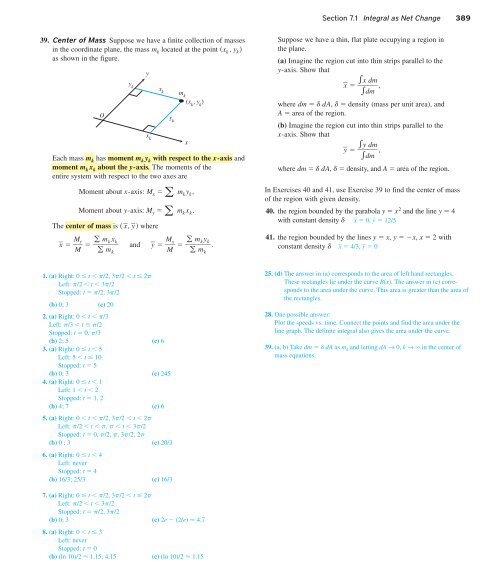Create successful ePaper yourself
Turn your PDF publications into a flip-book with our unique Google optimized e-Paper software.
Section 7.1 Integral as Net Change 389<br />
39. Center of Mass Suppose we have a finite collection of masses<br />
in the coordinate plane, the mass m k located at the point x k , y k <br />
as shown in the figure.<br />
O<br />
Each mass m k has moment m k y k with respect to the x-axis and<br />
moment m k x k about the y-axis. The moments of the<br />
entire system with respect to the two axes are<br />
Moment about x-axis: M x <br />
m k y k ,<br />
Moment about y-axis: M y <br />
m k x k .<br />
The center of mass is xJ, yJ where<br />
xJ M y m<br />
and<br />
M<br />
yJ M k x x m k y<br />
k<br />
k<br />
.<br />
m k<br />
M m k<br />
y<br />
y k x k m k(xk<br />
, y k )<br />
y k<br />
x k<br />
x<br />
Suppose we have a thin, flat plate occupying a region in<br />
the plane.<br />
(a) Imagine the region cut into thin strips parallel to the<br />
y-axis. Show that<br />
xJ x dm<br />
,<br />
dm<br />
where dm d dA, d density (mass per unit area), and<br />
A area of the region.<br />
(b) Imagine the region cut into thin strips parallel to the<br />
x-axis. Show that<br />
yJ y dm<br />
,<br />
dm<br />
where dm d dA, d density, and A area of the region.<br />
In Exercises 40 and 41, use Exercise 39 to find the center of mass<br />
of the region with given density.<br />
40. the region bounded by the parabola y x 2 and the line y 4<br />
with constant density d x 0, y 12/5<br />
41. the region bounded by the lines y x, y x, x 2 with<br />
constant density d x 4/3, y 0<br />
1. (a) Right: 0 t p/2, 3p/2 t 2p<br />
Left: p/2 t 3p/2<br />
Stopped: t p/2, 3p/2<br />
(b) 0; 3 (c) 20<br />
2. (a) Right: 0 t p/3<br />
Left: p/3 t p/2<br />
Stopped: t 0, p/3<br />
(b) 2; 5 (c) 6<br />
3. (a) Right: 0 t 5<br />
Left: 5 t 10<br />
Stopped: t 5<br />
(b) 0; 3 (c) 245<br />
4. (a) Right: 0 t 1<br />
Left: 1 t 2<br />
Stopped: t 1, 2<br />
(b) 4; 7 (c) 6<br />
5. (a) Right: 0 t p/2, 3p/2 t 2p<br />
Left: p/2 t p, p t 3p/2<br />
Stopped: t 0, p/2, p, 3p/2, 2p<br />
(b) 0 ; 3 (c) 20/3<br />
6. (a) Right: 0 t 4<br />
Left: never<br />
Stopped: t 4<br />
(b) 16/3; 25/3 (c) 16/3<br />
25. (d) The answer in (a) corresponds to the area of left hand rectangles.<br />
These rectangles lie under the curve B(x). The answer in (c) corresponds<br />
to the area under the curve. This area is greater than the area of<br />
the rectangles.<br />
28. One possible answer:<br />
Plot the speeds vs. time. Connect the points and find the area under the<br />
line graph. The definite integral also gives the area under the curve.<br />
39. (a, b) Take dm d dA as m k and letting dA → 0, k →∞in the center of<br />
mass equations.<br />
7. (a) Right: 0 t p/2, 3p/2 t 2p<br />
Left: p/2 t 3p/2<br />
Stopped: t p/2, 3p/2<br />
(b) 0; 3 (c) 2e (2/e) 4.7<br />
8. (a) Right: 0 t 3<br />
Left: never<br />
Stopped: t 0<br />
(b) (ln 10)/2 1.15; 4.15 (c) (ln 10)/2 1.15












